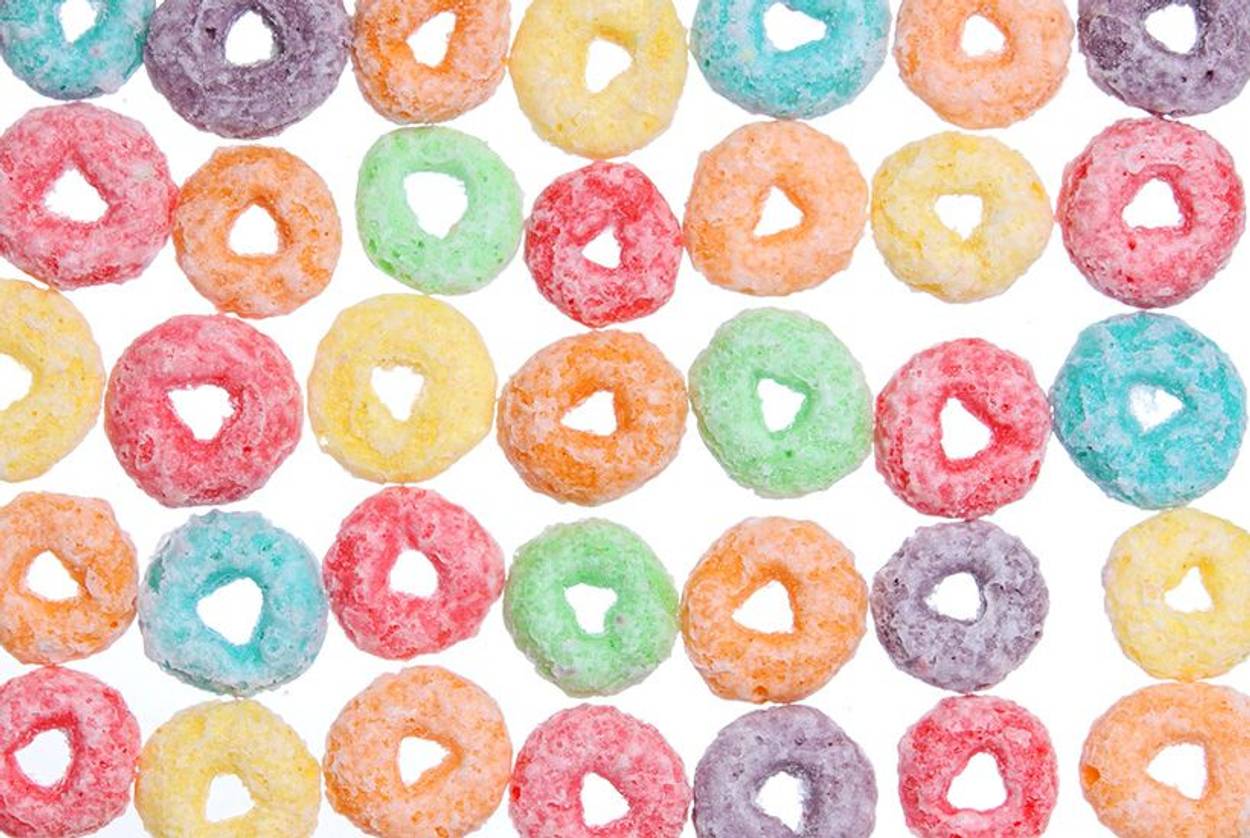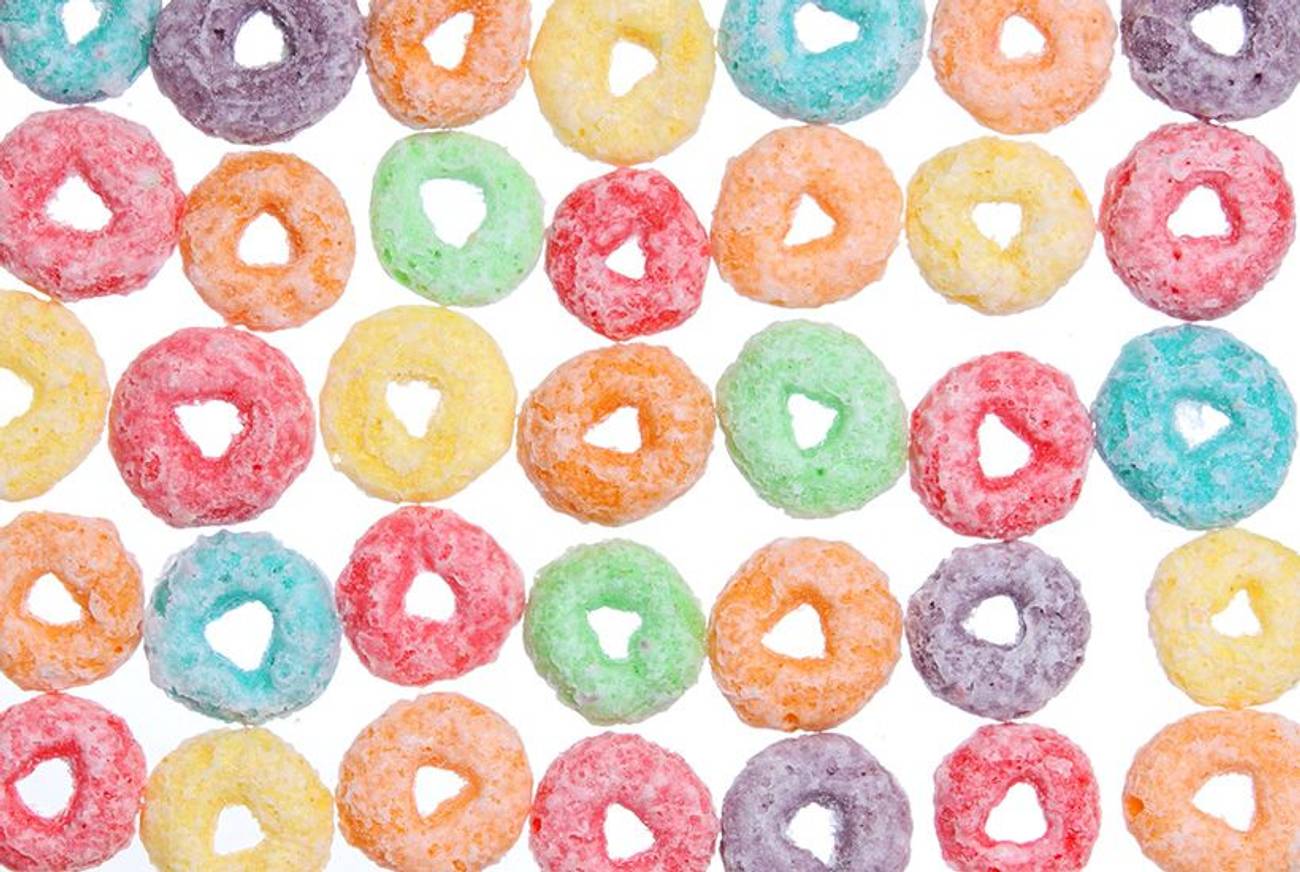How Froot Loops Helped Me Create a Culinary Connection to the Jewish World
Since both my parents were converts to Judaism, my family didn’t have any Jewish recipes to pass down. So I created my own.




Froot Loops were my first Jewish food.
I’m the child of two converts, which means that I was born and raised a Jew but without a family history of Judaism. Where other cultural Jews can feel Jewish by way of old family recipes and passed-down Seder plates and fragments of Yiddish, I can’t. (And unlike most converts, I can’t call on a personal conversion narrative, either.)
The closest I came to feeling at home in the long, filial history of Judaism was at my godparents’ house. To most, they were a quiet, intelligent rabbi and his warm, formidable wife; to me, they were Grandpa Dick and Grandma Barbara. I can still remember how their house smelled, like warm wood and yellowing paper, when I’d arrive every summer morning before day camp at our temple. I’d sit with my godmother, open one of those little boxes of kids’ cereal, and start the day. Eaten in those moments before my godfather drove us to temple, those Froot Loops seemed part of what it meant to belong, even partly, to a Jewish family.
What those mornings taught me (though I forgot the lesson for years) was that, while food is central to Jewish identity, the ingredients themselves matter less than how and when we experience them. Varicolored, sugary rings can be as Jewish as matzo balls, at the right time, with the right people. And Ina Garten, as much as a Jewish aunt, can help a wayward Jew find home.
My parents grew up Protestant, but they didn’t stay that way. Fed up with fire and brimstone, my father began studying with rabbis (including the man I would later know as Grandpa Dick) in the years after medical school and military service took him far from the Illinois farm where he grew up. Not long after he moved west to Tacoma, Wash., he converted. And then my mother converted when they married, a year before I was born. They were never, I think, terribly observant or devout Jews. But they had grown close with my godparents, and that closeness kept them (and so me) woven tight into the life of the synagogue.
When I was a kid, we attended Shabbat services frequently, if not always regularly. I went to Hebrew school for years, and every summer, there was temple day camp. (That’s before I spent several summers at a Conservative sleepaway camp with daily services—a bit of a shock for this Reform kid, but I adapted.) My childhood friends were mostly kids from temple, and some of my most vivid memories are of fasting on Yom Kippur and carnival games at Purim, of Manischewitz in thimble cups and peanut butter and jelly on matzo.
But I still often felt like the odd Jew out. There seemed to be a gulf between me and the other kids, like their histories made sense in the shadow of the temple’s ark and mine didn’t. My relatives, my ancestors—they’re all Protestants of one stripe or another. Our old family recipes are for casseroles and custard, not kreplach or kugel. In Hebrew school, when my classmates and I were supposed to figure out what tribe of Israel our predecessors had belonged to, the teacher told me to just pick one that seemed cool.
And then there were the holidays. Without Jewish grandparents, and in the absence of my parents’ childhood memories, I found myself coopting the sort of traditions that other Jews sometimes take for granted: At my godparents’ house, we’d break the Yom Kippur fast with lox and bagel chips, and on Passover we’d hunt an afikoman that always seemed to be hidden in the same place. Gefilte fish came on lettuce; matzo balls were just barely on the fluffy side of solid. The dining and living rooms would be packed for every Jewish holiday with my godparents’ children, their grandchildren, their friends. With me.
But shortly after my bar mitzvah, Grandpa Dick—the rabbi, my godfather, the leader of a city’s Jews—died. The temple I’d grown up in changed, utterly, now run by a very different rabbi with very different priorities. The house I’d felt most at home as a Jew in changed, utterly, now more emptied by grief rather than filled with family. Those changes, for which I was not equipped, combined at just the wrong moment with my transformation into a difficult, secretive, and self-destructive teenager.
And so, I began to drift away from Judaism. It wasn’t on purpose. It just seemed easy, natural—like something that just happens when you’re not weighed down by the anchor of blood and history.
I didn’t set foot in a synagogue for well over a decade, and buying discount Valentine’s Day candy at Target was about as close as I came to celebrating any holidays at all. At college, in Wisconsin, I fell in love with a disaffected ex-Pentecostal Christian, and we came to share religious vocabulary—arch, cynical, analytical—that distanced ourselves from the communities to which we had once belonged. I left matzo, and Froot Loops, behind.
It’s been almost 17 years since my bar mitzvah and more than 15 since the start of that long, slow drift. Over the past several years, though, something has shifted, and I’ve felt a tug back toward what I left behind. But so many years out, and now thousands of miles away from where I grew up, a turn back to Judaism couldn’t be just a turn to the past. Instead, it has been a matter of finding new ways to be Jewish in the present.
The tug really began a few years after I moved to Urbana, Ill., to get a Ph.D. in history from the University of Illinois. Other Jewish graduate students in the department started organizing holiday meals, gatherings to make this place where we all lived a little more like a place where we were all at home. But we come from different traditions. Most (other than me, of course) came from long, long lines of Jews, lines packed with traditions and recipes and habits. Only a few, though, had grown up in a synagogue, only a few had been bar or bat mitzvahed. We may all have considered ourselves Jews, but no two of us could probably agree about what that meant.
Which was, it turns out, a recipe for messy, raucous, perfect gatherings that made it possible to rethink what Judaism is to me. And food—the traditional and the Froot-y—was, once again these many years later, central to finding myself at home as a Jew.
At these gatherings, kasha varnishkes and mandelbrot share the table with pineapple-filled kugel and flourless chocolate cake, each brought by a very different Jew to the only apartment with a table big enough to hold us all. And the dishes I bring express a mutant Judaism that fits me perfectly. I try to recreate the gorgeous, nostalgic texture of my godmother’s matzo balls, but I add parsley to the dumplings themselves—a twist I learned not from my godmother or my nonexistent Jewish aunts but from an episode of Ina Garten’s Barefoot Contessa. Or when I make charoset, I grind walnuts and dates, mix in apples and honey, thus combining the Ashkenazi (chunky, with apples, walnuts, honey) and Sephardi (ground fine, with dried fruit) approaches to the symbolic—and now especially delicious—dish.
These days, I feel most Jewish when I’m making carrot ring. In part that’s because I learned how to make the deliciously savory cake from my godmother. (It’s not right unless you get some knuckle blood in the batter, she explained, enjoining me to only ever grate the carrots by hand and leaving the kosher status of human blood unexplored.) But mostly it’s because today I make it for holidays with friends. In a strange way, actually, I identify with the cake. Out of ordinary ingredients—carrots, flour, shortening, sugar, salt—comes something that, with only a little bit of time and a table full of friends, feels comfortably, perfectly Jewish.
Judaism is so much about the past, about telling stories in order to remember: plagues, destroyed temples, droughts. And it’s also, of course, about looking forward with hope and resolution into the future. “Next year in Jerusalem,” after all. What I’ve found, though, is that Judaism is also about what happens between before and after, in the satisfying fullness of the now. My Judaism gets expressed and experienced in small moments—grating carrots, mixing batter, simmering matzo balls, sitting around a table, tasting honey on my tongue—as much as it does in the grand sweep of time.
And looking back on my little boxes of Froot Loops and thimble cups of Manischewitz, I realize it always has.
Derek Attig, who blogs at Bookmobility.org, is writing a history of bookmobiles in the United States.